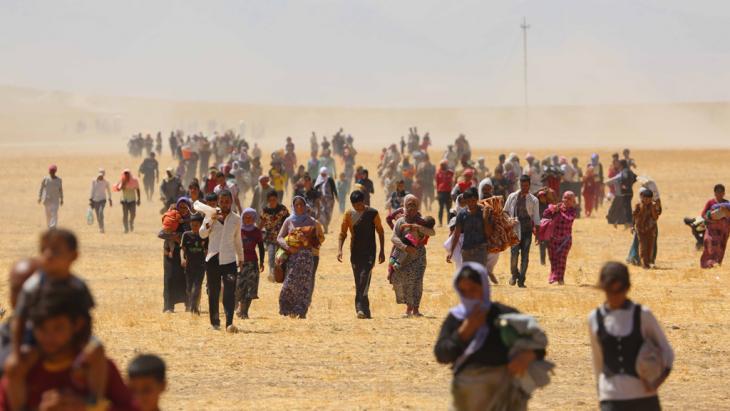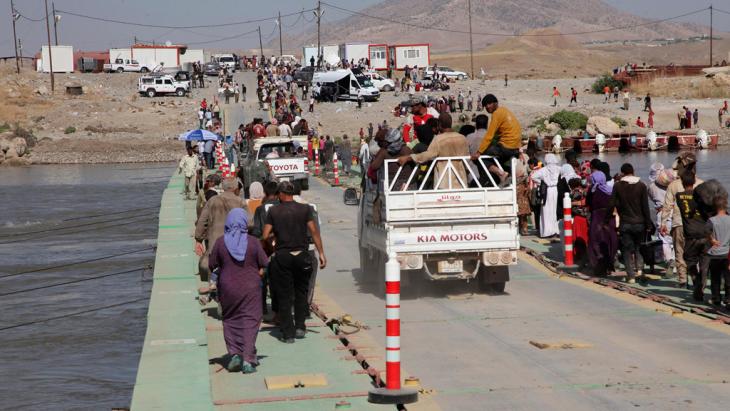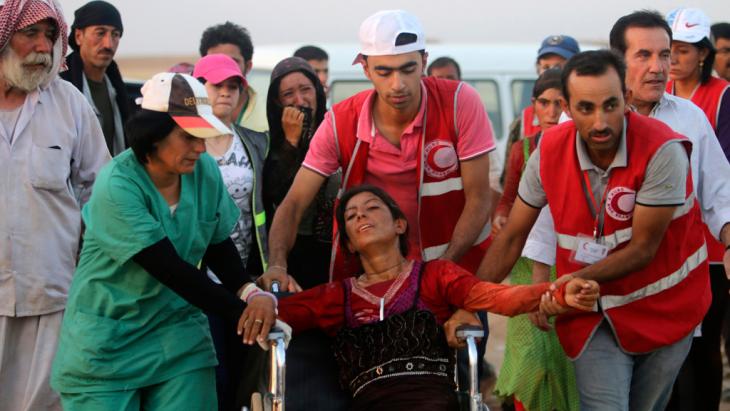Don't abandon us!

"We are 350 families in the mountains and without food and water. The number of those dying of thirst is rising. Please help us. I am writing this near the peak of the Sinjar mountains. My battery has almost run out."
Desperate pleas like this reach Hayri Demir in Hanover on a daily basis. It is there that the young journalist runs the Yazidi news portal "Ezidi Press". The site is deeply concerned about the fate of the Yazidis in Sinjar and the surrounding region in northern Iraq. It also seeks to present the most accurate account possible of the dramatic situation.
It is understandable that members of the community of exiled Yazidis in Germany are quick to talk of "genocide," given murders perpetrated against fellow believers and the kidnapping of hundreds of women and girls by IS ("Islamic State") jihadists.
The "Chronology of the Attacks on Yazidis" put together in recent days by "Ezidi Press" tends to give the impression that armed IS groups are using targeted executions to provoke the Yazidis into fleeing en masse – a strategy that has worked. The term "ethnic cleansing" seems more applicable here, which is the descriptor used by the Hanover-based Yazidi activist and political advisor Mirza Dinayi, who is currently in the Kurdish city of Erbil.

Threat to religious sites
There's more at stake than the lives of tens of thousands of Yazidis who have sought refuge in the Sinjar Mountains. They still face mortal danger despite the launch of aid campaigns. The religious minority's entire cultural home in the region near Sinjar is also under serious threat too: numerous religious sites have already fallen to the destructive fury of IS fighters.
Hayri Demir reports that smaller shrines both north and south of the Sinjar Mountain Range have been destroyed in a dozen villages, including in Siba Sheikh Khidr and Tel Azer as well as Zorava and Hirdan. The shock troops of the IS caliphate also launched an attack in the Shrine of Sherfedin in Sinjar, the most important religious site in the region. Inaccurate reports quickly spread in Arabic media that an explosion had struck the shrine there, which consists of two structures featuring the lamellar pointed towers typical of Yazidis' sacred architecture.
As a matter of fact, Yazidi self-defense forces, together with aid from Kurdish Peshmerga units, were able to stop the attack by IS militias. Specifically for the sake of protecting this central holy site, the local Yazidi community established the Sinjar Resistance Force several days ago, which has since reportedly recruited several thousand members, who are ready to fight.
Arguably the most holy site for Yazidis is the tomb of the mystic Sheikh Adi Ibn Musafir al-Umawi (1073–1163), a Sufi religious figure revered as holy among Yazidis, which is located in the Lalish Valley in Iraq's autonomous Kurdish region. At present, it doesn't seem to be directly under threat. It is followed in significance as a pilgrimage site by the Sherfedin Shrine in Sinjar. In Yazidi tradition, the shrine is particularly bound up with resistance and acts of heroism – points of reference for the troop currently seeking to protect it.

Fighting the "Sharia adherents"
Sherfedin was the son of Sheikh Hassan Ibn Adi, a distant relative and successor to the founder of the Yazidi faith, Sheikh Adi. During his lifetime in the mid-thirteenth century, the Yazidis faced persecution at the hands of the Sunni ruler of Mosul, Badr al-Din Lulu.
When a group of Yazidi fighters stood up to his troops in Lalish, most of them were killed, and Sheikh Hassan was captured and publicly hanged. His son Sherfedin managed to flee to Sinjar, where he reorganised a resistance force. Before dying in battle in 1257, he was still able to send a message to his fellow believers, which has been passed on as the Sherfedin Hymn and remains well-known among Yazidis today. In the Sinjar region in particular, Sherfedin is identified with the Mahdi, a Messiah figure in Islamic tradition, who is expected to emerge as a redeemer before the world's end.
In light of the ongoing struggle of defense in the city of Sinjar, this hymn takes on explosive import because it describes an eschatological battle in which the Yazidis stand up against attacks from "Sharia adherents" – the IS' murderous bands are well-known for considering themselves the true interpreters of Islamic religious law. In the Sherfedin Hymn, Yazidi fighters rally around their commander Sultan Ezi. At one point, the lyrics go: "Sultan Ezi, give us courage! / We will gather around you / Don't abandon us and leave us in the hands of Sharia."
Joseph Croitoru
© Qantara.de 2014
Translated from the German by Greg Wiser
Editor: Aingeal Flanagan/Qantara.de